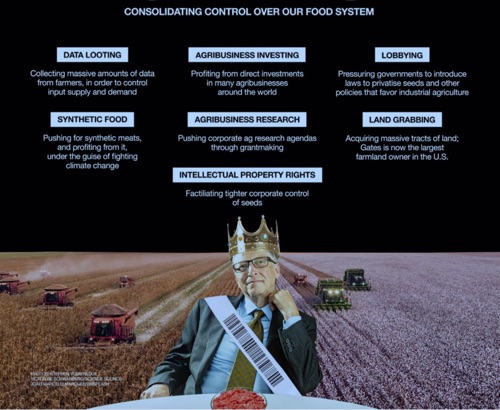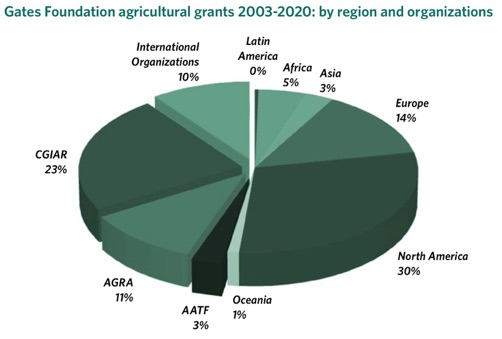News
22 June 2021
Bill Gates: philanthropy or business as usual?
If you ask people what they think of Bill Gates, many will reply that he is the greatest philanthropist of all times and a visionary. Some might even go as far as to add that he is a saint. They will mention ‘the billions given by Gates to improve our health and combat against hunger and poverty in Africa’. They will say they heard that he was ‘the only one who had foreseen the COVID-19 pandemic’. Others might wish him to take up political responsibilities, as UN Secretary-General or as President of the United States.
Others still, more critical, annoyed by Gate’s ubiquitousness and the continuous reference made to him by the media, may list some of the dark sides of the hero.
A crumbling image
Today the image of a clean, selfless and wise elder that Gates succeeded in projecting to the world, is crumbling. Little by little, evidence is being gathered that unveils the hidden facet of a person who, serving his interests, is “driving the global food system into the wrong direction”, according to the latest article published by GRAIN [read], after having been zealously concentrated on dominating the world health scene [read] and supporting big pharmaceutical corporations’ patent monopoly on COVID-19 vaccines. More and more proofs are being put forward to testify the fact that behind the man who created the largest Foundation in history, there is a canny businessman. Of late, like a toxic icing on the cake, there have been several predominantly anonymous ‘MeToo’ allegations against the former head of Microsoft [read].

Source: GRAIN, 2021.
The GRAIN article follows a piece dating back to 2014 analysing how the Gates Foundation was using its moneys, that hungerexplained.org had mentioned at the time [read]. In those days, the Foundation had emerged as one of the main donors in agriculture, spending around $500 million a year mostly to influence policies (particularly seed policies) and praize industrial agriculture with major transnational agrochemical firms like Monsanto.
Seven years later and after the publication by different sources of reports on the poor performance of the Gates-supported Alliance for a Green Revolution in Africa (AGRA) [read] and on the role of the Foundation in promoting GMOs in Africa and other controversial technologies such as synthetic beef, cheese and chicken for which Gates-funded Impossible Foods has several patents [read], GRAIN decided to check whether “the Gates Foundation had been receptive to the criticism of its food and agriculture funding” formulated in 2014.
Fighting hunger in the South by giving money to the North
Findings show that the Foundation has not changed and that it funded “a total of 1130 grants for food and agriculture, worth nearly US$6 billion of which almost US$5 billion is supposed to service Africa”. To finance this, the “Foundation’s Trust Fund, which manages the Foundation’s endowment, has big investments in food and agribusiness companies, buys up farmland, and has equity investments in many financial companies around the world”. In fact, today, Gates is the greatest landowner in the US [read].
Like in 2014, GRAIN found that the lion share of the Gates Foundation funding was directed to organisations based in North America (30%) and Europe (14%), but with activities, the Foundation claims, mostly implemented in Africa. The picture below shows that the Consultative Group on International Agricultural Research (CGIAR), AGRA and the African Agricultural Technology Foundation (AATF), as well as a few International Organizations, were among the main beneficiaries, illustrating a clear strategy aimed at influencing agricultural development thinking and research, while promoting ‘modern’ agrochemical- and GMO-based agriculture [read].

Source: GRAIN, 2021.
download pdf file: Gates_foundation_grants.jpg
The detailed analysis conducted by GRAIN shows that almost half of the money goes to universities and research centres in North America and Europe, mirroring a long US tradition of using aid funds to finance and influence the academic world.
In 2020, the Foundation launched its own research institute called “Gates Ag One”, established in Saint Louis, Missouri, not far from Monsanto headquarters, with the objective to speed up the development of new seeds and chemicals and get them to farmers in sub-Saharan Africa and South Asia more quickly [read].
The reality depicted by GRAIN and the figures analysed show that the Foundation is far from “fighting poverty, disease, and inequity around the world” as announced by its slogan on the first page of its website.
And GRAIN comments: “For contrast, Oxfam spends over half of all its funding directly in Africa, and more than a third in Asia and Latin America, a lot of it through local NGOs in these regions.”
The Foundation: a tool to gain influence and make business
Bill Gates has been using the billions invested in the Foundation to buy political influence. Many will remember the session during the COP21 in Paris in 2016, in which Gates appeared with Heads of State or, more recently, his participation in the “Leaders Summit on Climate”. The Foundation also works closely with the World Economic Forum (Davos), and its active members in the food and agriculture sector, such as agrochemical multinationals Bayer and Corteva (pesticides and seeds), and Yara (fertilizer), promoting corporate interests. With the Forum designated as a co-organizer with the United Nations of the forthcoming Food Systems Summit [read] and the president of AGRA nominated as Special Envoy of the UN Secretary-General for the Summit, it is quite clear that Gates has a huge opportunity to influence important decisions on the future orientation of the global food system.
At country level, the Foundation and AGRA use their resources to lobby for policies choices making the environment more business-friendly and facilitating access of farmers to commercial seeds and agrochemicals by getting official approval of new varieties, including GMOs. They also fund partners to make the promotion of biotechnologies, as in the case of Michigan State University.
Moreover, and it will be no surprise, with Microsoft being actively involved in Big data through its FarmBeats platform [read], AGRA and the Foundation are also championing digital agriculture in Africa [read].
It is not difficult to put the pieces of the puzzle together and discover what the picture looks like. It is clear and simple. Food and agriculture is becoming one of the key domains for the future. It is increasingly strategic, because food is not just a good among others. It is the basis of life. As climate changes, natural resources degrade, biodiversity diminishes, food will yet become a more critical area, and because of that, it will be a sector that offers huge business opportunities. By buying land, investing in technology (synthetic food, big data) and influencing policies to facilitate penetration into the sector of large corporations in which he has interests, Gates is expanding his empire.
Behind the philanthropist, he is and remains above all a businessman.
—————————————
To know more :
-
•GRAIN, How the Gates Foundation is driving the food system, in the wrong direction, 2021.
-
•GRAIN, Barbarians at the barn: private equity sinks its teeth into agriculture, 2020.
-
•GRAIN, How does the Gates Foundation spend its money to feed the world? 2014.
Selection of past articles on hungerexplained.org related to the topic:
-
•Opinions: Another False Start in Africa Sold with Green Revolution Myths, by T. A. Wise and J. K. Sundaram, 2021.
-
•Sustainable food systems: 2021 may be a turning point for food, … or it may not, 2020.
-
•Privatisation of development assistance: integrating further agriculture into the world market, 2018 (see particularly p. 12, in the pdf version).
-
•Large private Foundations: the lost opportunity of the Gates Foundation, 2014.
-
•The New Alliance for Food Security and Nutrition: a coup for corporate capital? by N. McKeon, 2014.
-
•Green revolution in Africa: more improved seeds for the continent, 2014.
Last update: June 2021
For your comments and reactions: hungerexpl@gmail.com


